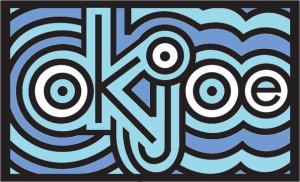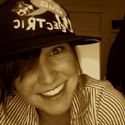Posts Tagged ‘Elon’
Yes, I’m in senior seminar right now with Michael Fels. We have a really great, dynamic group that sparks awesome conversation, even at 8am. In the accompanying Advanced Projects in Kinetic Imaging class, I’m working on an interactive video installation right now describing the process Burlington-based TS Designs uses to create their sustainable t-shirts, all within North Carolina, “from dirt to shirt”. I’m a publicity intern for them right now, and have gotten really excited about learning how they can grow, harvest, gin, spin, weave, and print a line of shirts all in this state. I want to illustrate this sense of community and nurturing through my next piece, with interactive attributes, maybe including seed planting or miniature models.

This is a logo that Saragusa created for her best friend, Joe Slocum's vice-presidential campaign at Elon University.
If you could describe your art in one word, what would it be?
Playful. I’m still a little kid deep down. I find it impossible to envision myself as an adult. I don’t do dark art. I don’t do sad art. I can’t see the point in dwelling on negativity when positive solutions and optimistic viewpoints can always be found and highlighted no matter what your subject matter is. I think that’s important for artists to remember. Bad things in the world can always be shown from the doom and gloom perspective, but that seems to be the easy way to go. Creative problem solving is very much needed in our world, and artists aren’t just pretty picture makers. We can be activists and educators, too.
How long have you been interested in art?
I have been telling stories and writing books and illustrating since I could hold a crayon. I am a very narrative-oriented person. If you sit down with me and let me tell stories all day, I will. I find that I can relate to just about anyone based on experiences, down to a very intimate level, just by exchanging life stories. This is very prominent in my art. I think it’s just an integral part of my personality to attempt to express myself in a non-verbal way. My friends’ and family’s ears need a break every now and then.
When I applied to Elon, I had no intention of becoming an Art Major. I aimed to be a part of the Athletic Training program, but that was eliminated and turned into the Exercise Sports Science program in 2007, a major not under the umbrella of the Elon College Fellows program to which I had been accepted. A little dejected, I was like “Hell, let’s give this art thing a shot.”
Where do you get your inspiration from?
My inspiration comes from dreams a lot of the time. I have incredibly vivid dreams that I write down in full detail in a very hidden place. My imagination generates millions of ideas and images every day and I hate the fact that I can’t write or draw all of them, but such is life. Like I was saying, sustainability is something I’ve been working hard to completely integrate into my art, but I also am working towards incorporating it into my lifestyle in my clothing, food, and recreational choices.
People inspiring me right now are eco-artists, like Lillian Ball, who just recently visited Elon last week. She was awesome, a totally committed activist and artist and community member who does incredible things for plants, animals, AND people. She’s definitely a mover and a shaker in the environmental world that I look up to.
What would your dream art project be?
I want to build a food co-op/art gallery/sustainable clothing boutique/performance space…all in a tree house. I am going to do it one day. It’s pretty much my ultimate goal in life. It encompasses literally everything I’m interested in: local food, community unification, sharing of art, dance and music, fashion, architecture, and being one with nature. I’m very Zen-minded, and developing this beautiful community space in and with the natural world would create a very positive energy and environment to foster these principles and ideas.
What are your plans as an art major following graduation?
I’m moving to California. There’s a lot of support for sustainability out West, not to mention my family has just moved to the San Francisco area, and graduation cannot come fast enough. I don’t want to wish away my senior year, but I’m a go get ’em kind of girl and I want to make changes in the world and create and continue to grow, and in my opinion, the sooner the better.
What would you like to say about the Elon Art Department? How has it prepared you?
These are the greatest people you will ever meet. The faculty is amazing–incredibly talented and supportive, not to mention hilarious and extremely dynamic. We have young, digitally-minded faculty, more experienced, classically minded faculty, and the ideas and conversation you can find floating around the art department are truly engaging, sometimes challenging, and usually wild. The little family I’ve come to have in the art department fosters my growth and skill building as an artist. Even more importantly, my peers and professors make me a better human being.
Senior digital art major Travis Butler describes his artistic vision in one word — “experimental.”
His work with animal bones, found objects, felt masks and mythical creatures gives the sense of a constructed reality never  before explored.
before explored.
Butler has spent the past three months creating and collecting pieces for the installation he will present for his senior art seminar in the spring. A mixed-media artist, Butler sketches, paints and works with fiber and digital programs. Through fiber art, fiber installation and digital imagery, Butler said he ultimately hopes to achieve a detached reality in his installation.
“My installation work uses the material of felt and found rusty, recycled and discarded objects to create an environment that seems weathered and frozen in time but soft like the wasteland of a forgotten dream,” Butler said.
Butler’s Original Masks
In the senior art seminar, students are expected to spend their senior year working on one project. They build a concept, work with faculty and other students, show their work and finally present and defend a thesis at the end of the year. Butler entered his fourth year already knowing what he wanted to produce.
“This past summer, I took a course at (Virginia Commonwealth University) where I learned different fiber techniques like felting,” Butler said. “I made two of the masks there.”
 These masks are perhaps the most noticeable elements in Butler’s installation. Unique in form and emotional expression, Butler makes the eyes and mouth for the masks separately with a basic fiber technique called coiling. The emotions and faces of the masks — which each take about seven to eight hours to create — emerge as the form is finalized and composed. Butler said he plans to create a community of about 10 masked figures.
These masks are perhaps the most noticeable elements in Butler’s installation. Unique in form and emotional expression, Butler makes the eyes and mouth for the masks separately with a basic fiber technique called coiling. The emotions and faces of the masks — which each take about seven to eight hours to create — emerge as the form is finalized and composed. Butler said he plans to create a community of about 10 masked figures.
“I think these anthropomorphic figures are the most recognizable because they could be related to humans or cute, cuddly creatures,” Butler said. “A connection is made between viewer and masked figure because both possess a spirit.”
Threads Tying Butler’s Work Together
This sense of spirituality, fantasy and mysticism surrounds all of Butler’s work, especially his sketches. In the installation, Butler takes this theme further, highlighting the soul and unknown history of the felt figures and the found objects that embellish them.
“The found objects contain a certain personality and history to them,” Butler said. “They can all be found on the sides of railroad tracks. But when seen in the context of the gallery, they take on new, fantastic lives. I like to think that when everyone leaves the building for the night, the figures let out a breath of air. Shadowy figures spring to life from their relaxed positions, and the silence of the white walls is broken.”
Butler said he hopes the setting and layout of his artwork will express an openness that emphasizes detachment, adventure, desire and discovery. Butler guides the viewer to experience the installation first as a removed participant, then to search for the adventure and alternate reality.
He said he leaves it to the imagination of the viewers, based on the material he has presented, to create their own stories, myths or histories.
Butler’s Artist Philosophy
As a contemporary artist, Butler does not want to control viewers. Instead, he presents his work and challenges them to appreciate it more than they may have appreciated other artwork — by literally becoming the art.
“To fully experience life, you can’t be stuck in the same routines,” Butler said. “You have to be adventurous and continually see things in new ways. In life, we are presented with questions. Should we keep doing what we are comfortable doing, or should we try new ways of thinking?”
Butler said he does not expect or want everyone to walk away from his work with the same understanding. Rather, he said he hopes they will experience the installation at different levels but ultimately grasp the larger themes of different levels of framing, searching and constructed space.
“Every adventure has a starting point,” Butler said. “In many ways, this installation piece is my starting point. I hope I can guide viewers to find their own adventures by sharing mine.”
